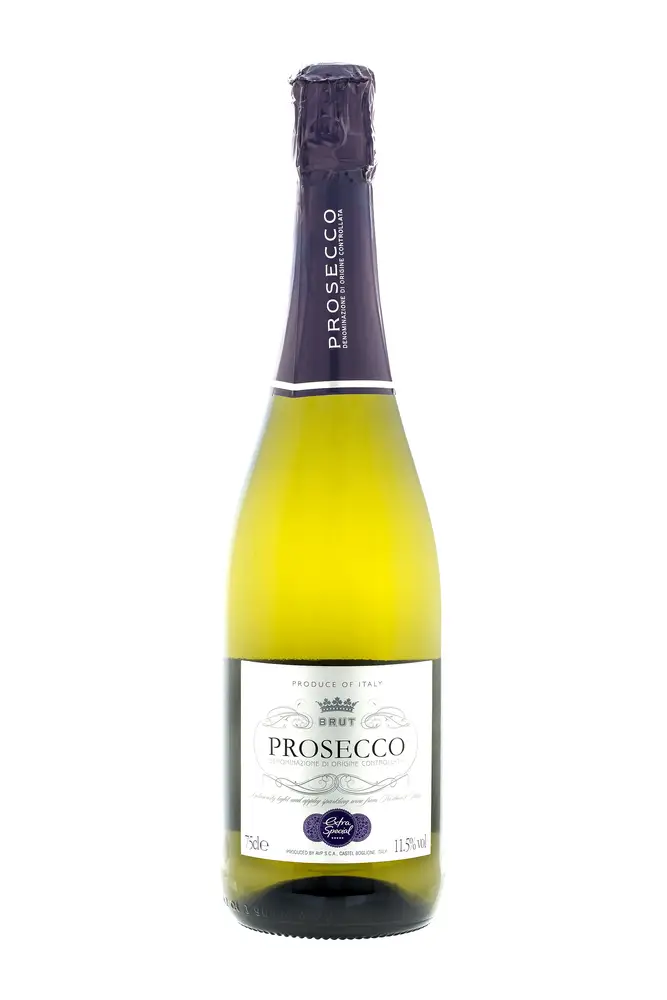If you’re getting tired of champagne or want a low-calorie alternative to your favorite sparkling wines, Prosecco may be the type for you! This increasingly popular wine is a sparkling white from Italy made with the Glera grape and works well as a brunch or lunch wine.
However, it has also become popular for those trying to lose weight due to its lower calorie content compared to other wines. But just how much lower in calories is it compared to other wines? Let’s take a look to find out!

Why Does Prosecco Have Calories?
Like all other wines, Prosecco has calories because of its fruit and sugar content. Sugar is the primary fuel for the body and is where we get most of our calories.
As a result, drinking Prosecco adds calories to your diet, depending on the brand and type that you purchase.
So, How Many Calories Are in Prosecco?
When examining Prosecco wine calorie content, it is crucial to help you understand a few basic facts.
First, when we talk about a wine glass, we’re discussing a 125 milliliter or four-ounce glass.
For bottles, it’s 750 milliliters or 24 ounces.
That means you get about six glasses from each bottle. So, just how many calories does a glass and bottle of the average Prosecco contain?
Well, our research discovered that a glass (4oz) of Prosecco has about 80 calories, meaning that a bottle (24oz) has 480 calories.
That might seem like a lot to some people. However, a typical glass of wine has about 228 calories per glass. Meaning Prosecco has 148 fewer calories. So a bottle has about 1,368 or 888 calories less.
In other words, you could drink almost three bottles of Prosecco to get the calories in a standard bottle of wine.
Low-calorie brands (all about 80 calories per glass) you may enjoy include:
- Cirotto – This brand contains a reasonably intense flavor caused by the fragile soil in this vineyard’s growing grounds. The overall taste is elegant and memorable.
- Noughty – If you want an alcohol-free Prosecco, Noughty is a good choice for you. It’s not only low in calories but low-sugar, vegan, and halal.
- Bellissima – Belissima contains a surprising array of floral aromas that help it stand out compared to others. It’s a good option for experienced wine fans.
That said, it is essential to know that some Prosecco wines may contain up to 120 calories per glass, as there are sweeter varieties with higher sugar content.
Frustratingly, most winemakers don’t print calorie information on their bottles, which can make finding a low-calorie option a bit harder.
Here are a few tips that will make this process a little easier to figure out.
How to Know Which Prosecco is Low in Calories

When reading a Prosecco label, you can use some cool tricks to gauge calorie content.
First, higher alcohol contents mean less sugar and, appropriately, fewer calories.
However, you can also read the label to find the Prosecco type among the four options below and use this information to track calories per glass (4oz) and bottle (24oz):
- Prosecco Brut – This very dry Prosecco option has almost no sugar and very low calories. Expect anywhere between 60 to 80 calories per glass or as little as 360 calories per bottle of wine.
- Prosecco Extra-Dry – While this label reads “extra-dry,” this variety is a little sweeter than Brut, meaning it has more sugar and slightly more calories. Expect anywhere from 80-90 calories per glass.
- Prosecco Dry – With a slightly higher sugar content than extra-dry, this Prosecco should have around 100 calories per glass, though potentially as high as 110. Once again, the “dry” on this label is misleading.
- Prosecco Demi-Sec – The sweetest Prosecco wine has about eight teaspoons of sugar per bottle, which gives it 120 calories per glass or 720 calories per bottle.
As you can see, even the higher calorie Prosecco options are surprisingly low in calories, meaning that they remain a popular option for many wine fans looking to lose weight. Especially those on the stringent keto diet.
But how exactly do they compare to various other wines on the market?
Let’s take a more in-depth look at this topic to help wine fans decide if Prosecco wine makes sense for their weight-loss needs.
Related: Sugar content in a wine glass.
Prosecco Calories vs. Other Wines and Alcohol Calories
Processo compares very favorably to other alcoholic drinks on the market in calories, including:
- Beer – A typical pint of beer has between 180-220 calories, depending on the brand. And while a pint is nearly four times bigger than a standard wine glass, beer drinkers typically enjoy a brew in a pint form rather than a small four-ounce glass.
- Cider – Alcoholic ciders get their delicious taste by having a high sugar content, meaning you can expect 220 calories per pint. Like beer, few people will enjoy cider in a four-ounce glass and shoot more for a pint or bigger.
- Vodka – You get about 90-100 calories per shot of vodka, which might seem comparable to Prosecco at first. However, the average shot glass is 30 milliliters, meaning you’d get about 375 calories when drinking four ounces of vodka.
- Other Liquors – Rum, gin, whiskey, and tequila all have about 110 calories per shot, meaning you’ll get well over 400 calories if you were to drink four ounces. You’d also be far more drunk and likely drink far more than the recommended 14 alcohol units per week.
- Red Wine – The average red wine compares favorably to these other alcohol options, with about 160 calories per four-ounce glass. However, that’s still far above the 120 calories that you get from the sweetest and most calorie-dense Prosecco wines.
- White Wine – You’ll usually get far fewer calories in white wine than you will reds. However, you still get about 120 calories per glass of white wine, meaning that it’s comparable to the sweetest Prosecco but not as low as a Brut Prosecco.
- Port Wines – A great glass of dessert wine is typically going to have as many as 165 calories per glass, though some might have as much as 180 or more. Port wines are generally suitable for people who want a tasty wine and don’t plan to drink a whole bottle.
What Does Prosecco Taste Like?
Prosecco is classed as a medium-bodied white wine with few tannins.
Those who love whites or sparkling wines will likely love this variety and find its high acidity is balanced very well by its many tastes and aromas.
Take a sniff before drinking, and you’ll find apple, citrus, and pear scents lingering in your nose, providing a great pairing with the overall taste quality.
Expect tastes like peach, lemon peel, tropical fruit, pear, cream, and even floral notes. Some people even find tastes of honeysuckle.
With its bubbly texture and fairly yeast-tinted flavor, you can anticipate a variety of different flavors with this drink.
It typically works well for those who like lighter or less heavy wines and is often compared to a lager beer in texture and overall weight.
Handy tip: Prosecco works well for Mimosas. Why waste expensive champagne when a nice sparkling Prosecco will do the job?
Related: How long does Prosecco last?
Health Benefits of Prosecco
Amazingly, Prosecco may provide you with many health benefits when consumed in moderation.
Its high concentration of various antioxidants and minerals and nutrients may provide:
- Heart Health Benefits – Wine contains healthy polyphenols or plant compounds that help lower blood pressure and increase your blood circulation.
- Skin Appearance Boosts – Prosecco’s antioxidants help to provide a more even skin tone that can help you look and feel better about yourself as a person.
- Diabetes Management – With almost no sugar, sparkling wines like Prosecco can decrease your risk of diabetes by 13% by carefully balancing your sugar content.
- Respiratory Health Improvement – Prosecco wine lacks the high sulfite levels common in other alcohols, which can help with asthma-related symptoms and support your overall lung health.
- Memory Help – A few glasses of Prosecco can often combat the effects of memory loss by providing your brain with some antioxidant help.
Surprisingly, Prosecco may even help fight dementia risks, boost your mood by releasing endorphins, and fight colds and flu conditions, so try it out if you want a healthy drink alternative.
You want red wine to get the most health benefits from any wine.
Prosecco Calories FAQ
Is Prosecco More Fattening Than Wine?
Prosecco does not have a high calorie or sugar content, meaning it is far less fattening than other wines. By fattening, we mean likely to make you gain weight: wines typically have very little fat content.
Is Prosecco Good For Weight Loss?
Prosecco may have some real health benefits, but extra calories will likely hinder your weight loss. If you have to drink wine on a weight-loss routine, choose Prosecco. But drink none for the best results.
How Many Calories Are in a 750ml Bottle of Prosecco?
If going by the 80 calorie average (4oz glass) and multiplying by six glasses per bottle, the average 750-milliliter bottle of Prosecco has about 480 calories.
How Many Calories Are in a Glass of Prosecco?
The average Prosecco has about 80 calories per 125 milliliter or four-ounce glass. Some Prosecco wines may have as low as 60, though they often have no alcohol.
Is There a lot of Sugar in Prosecco? Does it Have More Sugar Than Wine?
Prosecco has about 4-6 teaspoons of sugar per bottle, considered very dry. Compare that to the eight to 20 teaspoons you get in other wines.
Is a Bottle of Prosecco a Day Too Much?
It’s typically not healthy to drink a bottle of Prosecco a day, as it is an extra 480 to 720 calories per day. Not to mention the other health concerns with excessive alcohol use. Furthermore, it’s nine alcohol units of your weekly 14 healthy units, limiting you for drinks later in the week.
- Shrimp Cocktail (and More) Wine Pairing Guide - 09/06/2022
- What Wine Serving Sizes Look Like: Standard Size and More - 08/06/2022
- How Much Sugar is in Wine: Glass and Bottle Sugar Content - 08/06/2022






